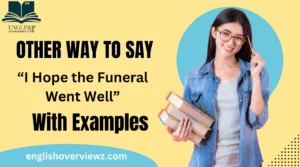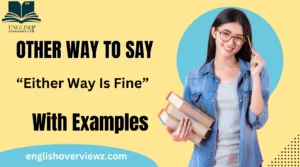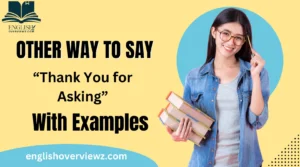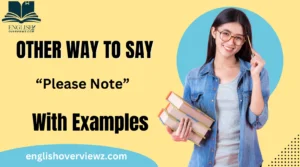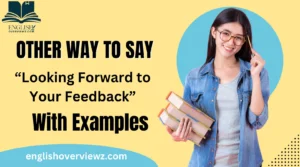Ever had someone share something helpful, and you just reply with, “Good to know”? It works, sure, but let’s be honest—it can feel a bit dry. If you want your words to feel more personal, warm, and thoughtful, this article is for you! We’re about to explore 20 friendly, natural, and meaningful alternatives that will help you express care and curiosity in a way that feels genuine. Trust me, these little phrases can make conversations brighter!
So, let’s dive in and sprinkle some charm into your everyday chats!
What Does “Good to Know” Mean?
“Good to know” is a simple way to show that you’ve learned something useful or interesting. It’s like giving a quick nod of appreciation for the info. Usually, we say it when someone shares a tip, a fact, or even just an update. It keeps the conversation going without sounding too excited or too flat.
In short, it’s a handy phrase for acknowledging helpful information!
Is It Professional/Polite to Say “Good to Know”?
Yes, it is! “Good to know” is polite, neutral, and fits well in both casual and professional conversations. But here’s the catch—it can feel a little cold if overused. Imagine your friend shares exciting news, and you just say, “Good to know.” It might feel like you’re not super interested. So, it’s safe, but sometimes, you might want a bit more sparkle.
Pros and Cons of Saying “Good to Know”
Before we jump into the alternatives, let’s weigh it out!
Pros:
- Quick and easy
- Works in any setting
- Neutral tone (safe!)
Cons:
- Feels a bit basic
- Can sound dull if overused
- Might not show enough excitement
That’s why we’re here—to give you better, warmer options!
Synonyms for “Good to Know”
- That’s Really Helpful
- I’m Glad You Told Me
- That’s Useful to Know
- Thanks for Pointing That Out
- That Makes Sens
- That’s Interesting!
- Thanks for the Heads-Up
- I Appreciate the Info
- Good to Have in Mind
- Thanks for Sharing That
- Noted, Thanks!
- I’ll Keep That in Mind
- That’s Worth Knowing
- I’m Glad You Brought That Up
- Oh, That’s Handy!
- I See What You Mean
- That Clears Things Up
- Appreciate the Heads-Up
- I’ll Make a Note of That
- Thanks for Keeping Me in the Loop
1. That’s Really Helpful!
This one is like giving a little high-five to the person who shared the info. It shows you appreciate their effort.
Scenario Example:
Subject: Re: Update on Project Timeline
“Hi Emily,
That’s really helpful! Now I can adjust our plans accordingly. Thanks a ton for keeping me in the loop.”
Best Use:
When you want to show genuine appreciation for useful info.
Additional Note:
Adds a positive tone and shows you’re truly grateful.
2. I’m Glad You Told Me
This feels warm and personal, almost like you’re saying, “I appreciate you.”
Scenario Example:
Subject: Heads-Up on System Downtime
“Hey Jake,
I’m glad you told me! I’ll make sure to save my work beforehand.”
Best Use:
Perfect when you want to show relief or appreciation for timely information.
Additional Note:
Great for both friendly chats and work emails!
3. That’s Useful to Know
It’s direct but feels a bit more thoughtful than just “good to know.”
Scenario Example:
Subject: Changes to the Meeting Schedule
“Hi Sarah,
That’s useful to know! I’ll adjust my calendar now.”
Best Use:
When the info directly impacts your plans or tasks.
Additional Note:
Sounds practical and shows you’re actively listening.
4. Thanks for Pointing That Out
A kind way to say you appreciate their attention to detail.
Scenario Example:
Subject: Re: Mistake in the Report
“Hi Mark,
Thanks for pointing that out! I’ll fix the error right away.”
Best Use:
When someone helps you avoid a mistake.
Additional Note:
Shows gratitude and attentiveness.
5. That Makes Sense
Simple and reassuring, like you’re following along with the conversation.
Scenario Example:
Subject: Explanation of the New Policy
“Hi Lisa,
That makes sense. Thanks for explaining it so clearly!”
Best Use:
When someone explains something that clears up confusion.
Additional Note:
Helps keep the conversation smooth and positive.
6. That’s Interesting!
A friendly way to show curiosity and keep the chat lively.
Scenario Example:
Subject: Re: Market Trends Update
“Hi Alex,
That’s interesting! I hadn’t seen that report yet.”
Best Use:
When you want to show genuine curiosity.
Additional Note:
Great for sparking further conversation!
7. Thanks for the Heads-Up
Perfect when someone gives you advance notice about something.
Scenario Example:
Subject: Maintenance Scheduled for Friday
“Hi team,
Thanks for the heads-up! I’ll make sure everything’s backed up before then.”
Best Use:
When someone shares time-sensitive information.
Additional Note:
It’s casual yet still polite.
8. I Appreciate the Info
Simple, polite, and shows gratitude.
Scenario Example:
Subject: Update on Delivery Schedule
“Hi Kevin,
I appreciate the info. That helps me plan my week better!”
Best Use:
When you want to sound professional and thankful.
Additional Note:
Works well in formal settings too.
9. Good to Have in Mind
Feels casual but thoughtful, like you’re keeping it in your mental notebook.
Scenario Example:
Subject: Re: Client Preferences
“Hey Maya,
Good to have in mind. I’ll make sure to prepare accordingly.”
Best Use:
When the info is useful for future reference.
Additional Note:
Sounds natural and shows you’re taking note.
10. Thanks for Sharing That
It’s warm and acknowledges the effort of the other person.
Scenario Example:
Subject: Re: Article Recommendation
“Hi Emma,
Thanks for sharing that! I’ll give it a read later today.”
Best Use:
When someone shares tips, resources, or insights.
Additional Note:
Keeps the tone friendly and engaged.
11. Noted, Thanks!
Quick, sharp, and efficient. Shows you’ve received and acknowledged the info.
Scenario Example:
Subject: Change in Project Deadline
“Hi Sam,
Noted, thanks! I’ll update the team right away.”
Best Use:
When you want to sound efficient and responsive.
Additional Note:
Very handy in fast-paced environments.
12. I’ll Keep That in Mind
A thoughtful way to show you’re paying attention and will remember it.
Scenario Example:
Subject: Client Call Preparation
“Hi Clara,
I’ll keep that in mind for the meeting. Thanks for letting me know!”
Best Use:
When you want to show you’ll remember and act on the info.
Additional Note:
Great for future planning.
13. That’s Worth Knowing
Adds a bit of charm while showing you see the value in the info.
Scenario Example:
Subject: Product Feature Update
“Hi Liam,
That’s worth knowing! I’ll update our sales materials.”
Best Use:
When the information adds valuable insight.
Additional Note:
Makes you sound curious and appreciative.
14. I’m Glad You Brought That Up
Shows appreciation for someone raising an important point.
Scenario Example:
Subject: Feedback on Project Strategy
“Hi Mia,
I’m glad you brought that up! It’s something we definitely need to consider.”
Best Use:
When someone shares a thoughtful or helpful comment.
Additional Note:
Shows you value their input.
15. Oh, That’s Handy!
Casual and fun, like you’ve just discovered a little life hack.
Scenario Example:
Subject: Shortcut for New Software
“Hi Ben,
Oh, that’s handy! Thanks for the tip.”
Best Use:
For tips, tricks, or shortcuts.
Additional Note:
Adds a playful, light-hearted touch.
16. I See What You Mean
Reassuring and shows you understand their point.
Scenario Example:
Subject: Clarification on Guidelines
“Hi Natalie,
I see what you mean now. Thanks for the clarification!”
Best Use:
When someone explains something clearly.
Additional Note:
Helps build connection and understanding.
17. That Clears Things Up
Great for when someone explains something that was confusing.
Scenario Example:
Subject: Explanation of Billing Process
“Hi Oliver,
That clears things up! Thanks for walking me through it.”
Best Use:
When you finally understand something tricky.
Additional Note:
Shows relief and appreciation.
18. Appreciate the Heads-Up
A slightly shorter, casual twist on “Thanks for the heads-up.”
Scenario Example:
Subject: Server Downtime Notification
“Hi Team,
Appreciate the heads-up! I’ll make sure to save my progress.”
Best Use:
For quick, casual acknowledgments.
Additional Note:
Efficient and friendly.
19. I’ll Make a Note of That
Shows you’re taking the info seriously and will remember it.
Scenario Example:
Subject: Notes from Client Meeting
“Hi Jenna,
I’ll make a note of that. Thanks for passing it along!”
Best Use:
When you want to show you’re keeping track.
Additional Note:
Sounds responsible and organized.
20. Thanks for Keeping Me in the Loop
Perfect for when someone updates you along the way.
Scenario Example:
Subject: Project Status Update
“Hi Tom,
Thanks for keeping me in the loop! It’s great to stay updated.”
Best Use:
When you appreciate ongoing updates.
Additional Note:
Builds strong, collaborative communication.
Conclusion
See? There are so many fun, warm, and thoughtful ways to say “Good to know”! Whether you’re writing to a friend, a coworker, or a client, these alternatives will help your messages sound more personal and engaged.
Next time you’re about to type “Good to know,” pause and pick one of these instead—you’ll instantly make your conversations feel more natural and friendly!


